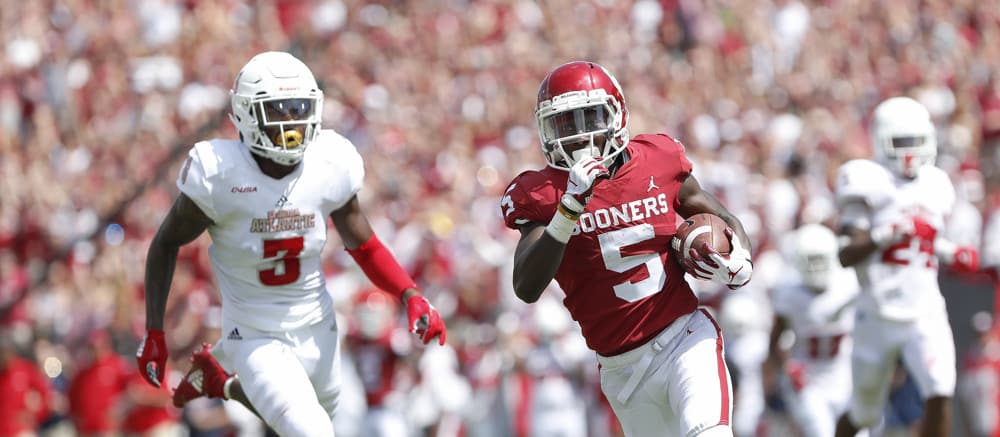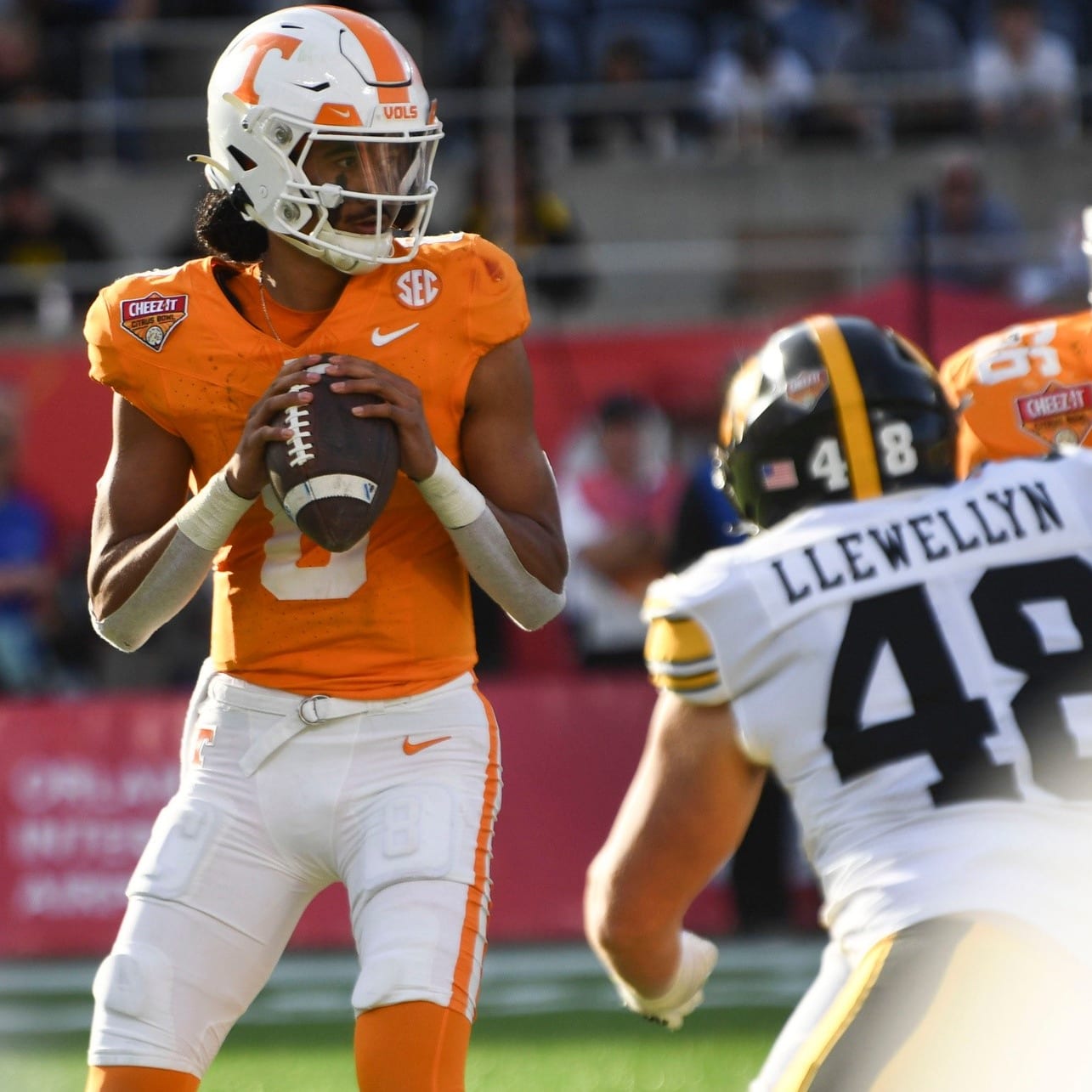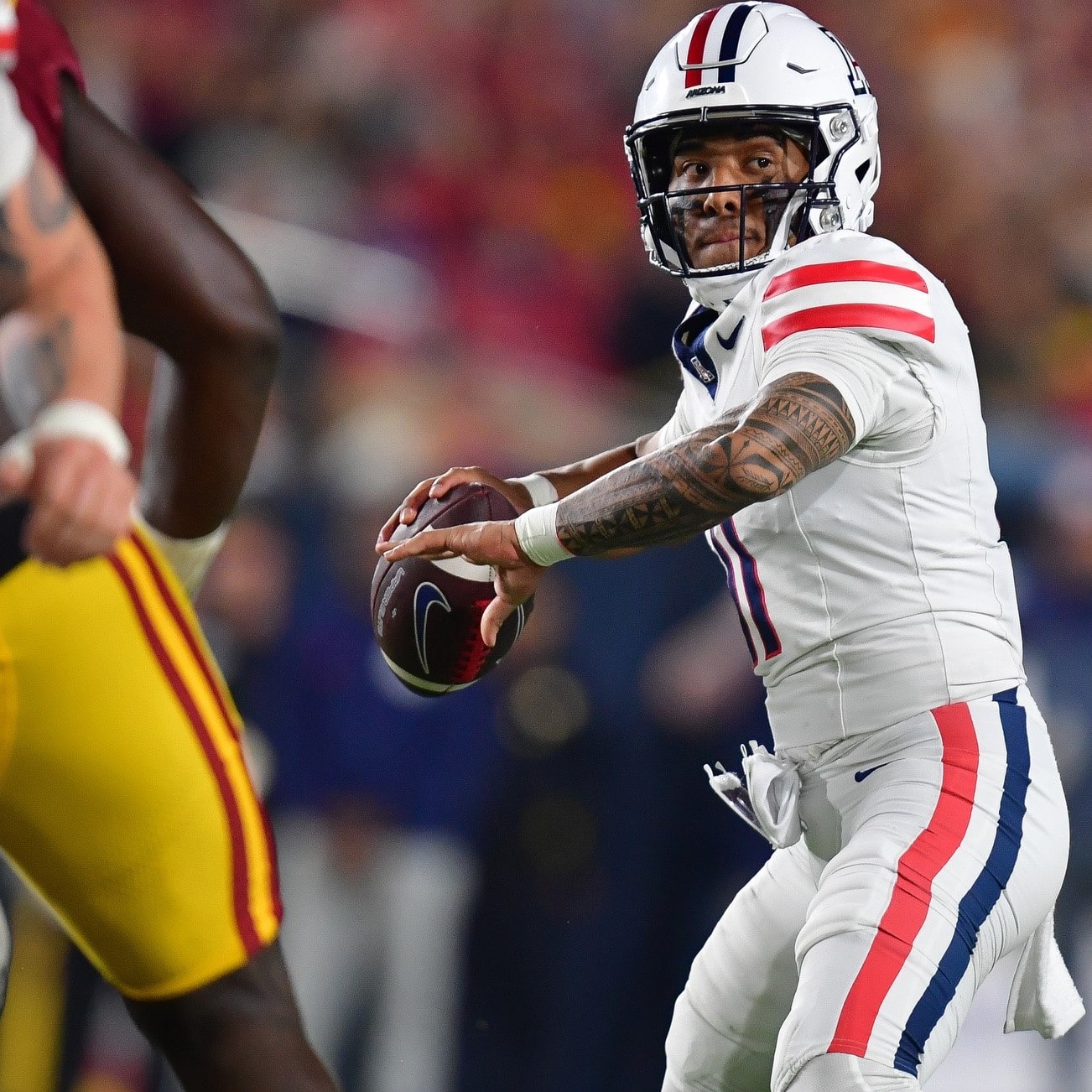This article is part of our Dynasty Watch series.
With the underclassman draft entrants declaring their intentions and leaving school behind, some big names have finalized their eligibility for selection in the 2019 NFL Draft, and it might not be long from now that we'll be considering those names in our fantasy drafts. They are of course of immediate interest in dynasty formats, but you'll want to know them for your redraft considerations as well, especially for when bye weeks and injuries hit.
We'll be writing extensively on the dynasty and redraft projections of the 2019 class in general, be it rankings, sleeper prospects, Senior Bowl and combine analysis, dynasty league rookie mocks, and maybe other things, but in the short term I'll try to get timely profiles written up for the most recently declared underclassmen of note. Since I'm working backward time-wise, the first names are Marquise Brown (WR, Oklahoma), Dillon Mitchell (WR, Oregon), Darius Slayton (WR, Auburn), Miles Sanders (RB, Penn State), and Jordan Scarlett (RB, Florida).
Marquise Brown, WR, Oklahoma (5-10, 168)
I think Brown is the prospect people wanted Dede Westbrook to be. Westbrook is a fine player for the Jaguars, but Brown applies to the game similarly and should put forth superior workout metrics to complete a prospect profile that already has the benefit of exceptional production and film.
Westbrook ran a 4.39-second 40-yard dash in a pro day setting at 6-feet, 178 pounds, and he was absurdly productive at Oklahoma himself with 80 catches for 1,524 yards and 17 touchdowns on 108
With the underclassman draft entrants declaring their intentions and leaving school behind, some big names have finalized their eligibility for selection in the 2019 NFL Draft, and it might not be long from now that we'll be considering those names in our fantasy drafts. They are of course of immediate interest in dynasty formats, but you'll want to know them for your redraft considerations as well, especially for when bye weeks and injuries hit.
We'll be writing extensively on the dynasty and redraft projections of the 2019 class in general, be it rankings, sleeper prospects, Senior Bowl and combine analysis, dynasty league rookie mocks, and maybe other things, but in the short term I'll try to get timely profiles written up for the most recently declared underclassmen of note. Since I'm working backward time-wise, the first names are Marquise Brown (WR, Oklahoma), Dillon Mitchell (WR, Oregon), Darius Slayton (WR, Auburn), Miles Sanders (RB, Penn State), and Jordan Scarlett (RB, Florida).
Marquise Brown, WR, Oklahoma (5-10, 168)
I think Brown is the prospect people wanted Dede Westbrook to be. Westbrook is a fine player for the Jaguars, but Brown applies to the game similarly and should put forth superior workout metrics to complete a prospect profile that already has the benefit of exceptional production and film.
Westbrook ran a 4.39-second 40-yard dash in a pro day setting at 6-feet, 178 pounds, and he was absurdly productive at Oklahoma himself with 80 catches for 1,524 yards and 17 touchdowns on 108 targets his senior year. But Westbrook turned 23 in that season, which cheapens the significance of the numbers a bit, and Brown should outdo Westbrook's workout metrics. Brown turned 186 targets over the last two years into 132 catches for 2,413 yards (13.0 YPT, 71 percent catch rate), and since he won't turn 22 until this summer I think there is more prospect value in Brown's production despite Westbrook's truly ridiculous senior season numbers.
It's easy to forget, but at the time of Westbrook's dominant 2016 season he was talked of as a candidate to be a first-round pick and the first receiver selected. The thinking was that he would be a DeSean Jackson sort of threat that kills the defense downfield with burning speed. But Westbrook turned out to be merely 'very fast,' whereas Brown is truly a burner more in the mold of Jackson. When you watch tape of Brown you'd sooner bet he runs in the 4.2s than the 4.4s. Brown isn't just fast, he's one of the fastest players in football. Baker Mayfield himself said that Brown has 'another gear' when discussing who was faster.
Brown's game plays from both the slot and out wide, which means if he lands with a decent coordinator he will be tough to scheme against. His light build limits his projection somewhat, but guys like T.Y. Hilton and the previously mentioned Jackson have already proven this template can work when you have the skills and speed that Brown does. If Brown runs a 4.35 40 at the combine at 175 pounds, I think he'd be a great bet to go in the first round. He's one of the most valuable assets in the upcoming draft and is absolutely a candidate to make a mainstream impact in redraft leagues if he gets a big role out of the gate.
Projected round: Top 40
Dillon Mitchell, WR, Oregon (6-2, 189)
Mitchell doesn't seem like a threat to crash the first round, but he's an interesting prospect whose traits should be useful to almost any offense, especially if there are slot snaps up for grabs. He was one of the top recruits of the 2016 class, and it may be pertinent to note that he was also a standout basketball recruit in that class. The ball skills and vision requirements of playing point guard really do correlate to football tasks like route running and catching, especially from the slot.
Mitchell's application to the NFL game would likely resemble those of lankier slot receivers like Keenan Allen, Robert Woods, and Tyler Boyd. Rashard Higgins is another player Mitchell's style might resemble. As far as where he lands on the quality question, I think for now I'd guess that Mitchell ranks somewhere between Boyd and Higgins, most likely a third-round type but with a good chance for the second.
You can only tell so much from tape, but Mitchell does not look fast. That's okay, because the comps I previously mentioned are all 'slow' by outside receiver standards. They win with route running in the slot primarily, and from there they're carried by their natural abilities to turn and run with the ball. That might seem obvious, but only subtle shades distinguish great players from good ones and decent ones from sub-replacement level, and it's harder than it looks to run your route effectively while minding the location of the defenders around you in the most congested part of the field. Mitchell seems to have that natural smoothness necessary to operate efficiently even with a storm of jerseys flying around him.
Mitchell wrapped up the last two seasons with 117 catches for 1,701 yards and 14 touchdowns on 198 targets (59.1 percent catch rate, 8.6 YPT). The YPT figure is very good in an offense that otherwise averaged 7.8 YPA over that span. As much as the YPT helps, you'd like to see a higher catch rate than that, even with the Ducks only completing 61.6 percent of their passes as a whole in those two years.
Projected round: 3-4
Darius Slayton, WR, Auburn (6-2, 190)
Slayton is an elusive evaluation. You have to read between the lines quite a lot when considering his production at Auburn, where an atypical system and its novel roles make it difficult to isolate and evaluate the pertinent traits for Slayton's NFL projection.
The most basic summary with Slayton is that he looks like an imposing athlete, but his production was a bit messy and the tasks he was assigned in the Gus Malzahn offense just aren't similar to what he'll be doing in the NFL. When a guy has little history of executing NFL tasks, then we have to guess whether that's the case because he can't do those tasks or if his college coaches simply never asked him to. It's a similar description to recent Auburn wideout prospects Sammie Coates and Ricardo Louis, who had varying production questions of their own despite brilliant athleticism otherwise. Coates was a third-round pick and Louis a fourth rounder. Slayton may be a better athlete than either, however – he's been credited with a 4.35-second 40-yard dash in the past and ran the 100m in 10.53 seconds in high school. Slayton's frame has room to weigh much higher than 190, so he's a candidate to run the 40 in under 4.4 seconds and at over 200 pounds.
Of the two, Slayton is more similar to Coates. Both receivers jump out on tape for their vertical explosiveness, and both players had numbers that indicate limitations as an underneath and intermediate receiver, which often speaks to route running limitations generally. We know he can run very fast in a straight line, but we don't know whether he can do more. He finished the last three years with 79 catches for 1,605 yards and 11 touchdowns on 167 targets. The anemic catch percentage of 47.3 is no doubt explained by his high depth of target, and it's in any case offset by the 9.6 YPT.
I haven't been able to watch much of Slayton yet so I can't draw on any anecdotes to narrow my conception of him, but in the meantime I think I'm mostly optimistic pending certain details as far as his workout metrics. Because the Auburn system is so goofy there will be a lot of projection involved in Slayton's prospect profile, but he was consistently explosive at Auburn and he might have the right combination of tools and innate skill to develop the underneath and intermediate parts of his game in that case. I think he's a volatile mid-round projection at the moment, with the ability to go as high as the second round if he kills the combine and as late as the sixth round if he tanks there. I think the comparison for now is someone like Coates or maybe Chris Conley.
Projected round: 3-5
Miles Sanders, RB, Penn State (5-11, 215)
Sanders is a pretty strange running back prospect, with some substantial but potentially fixable concerns and some indications of upside otherwise.
It's easy to look at Sanders' stats and presume him a one-dimensional back who's liable to see the bench in hurry-up situations. He totaled just 24 receptions for 139 yards on 35 targets in 2018, good for a catch rate of 68.6 and a YPT of 4.0. Those are brutal numbers, but this might be a case of underdevelopment rather than a true limitation with Sanders. He consistently shows standout athleticism on tape, including impressive balance that should generally imply the necessary coordination to catch and run as a receiver. Maybe he's never able to split out wide as more than a decoy, but Sanders should at least be able to develop into a functional screen and shovel pass target.
Even more pressing than Sanders' pass-catching questions is his propensity for fumbles, as he dropped the ball 10 times on just 308 touches in three years. I'm pretty sure that's the worst I've ever seen. Ameer Abdullah is probably the second-most prolific fumbler I can recall, with 23 on 978 touches. Aside from initial struggles as a rookie, Abdullah has mostly gotten his fumbles under control, for whatever that's worth.
If Sanders can fix his fumbling issue and show development in passing situations, then it's easy to imagine him proving an explosive asset. He may or may not be fast, I can't really tell, but he at the very least possesses uncommon balance, affording him standout stop/start and change-of-direction abilities. That balance also grants him an uncommon ability to bounce of tacklers, implying significant yards-after-contact upside. He consistently shows good anchor and motor, too. In 2018, his lone year as starter after previously backing up Saquon Barkley, Sanders ran for 1,274 yards (5.8 YPC) and nine touchdowns.
Because his immediate application is in question, Sanders might be at risk of sliding a bit in the draft all the same. Teams don't really look to stash developmental running backs since the position is so replaceable, and that kind of fumbling simply will not fly in the NFL. I would guess he goes in the fifth or later, but he could have unique upside for the range if his workout metrics are as good as his athleticism looks on tape. He might be comparable to a guy like Bryce Brown or something like that; mercurial for his flaws but undeniably explosive.
Projected round: 5-7
Jordan Scarlett, RB, Florida (5-11, 210)
Scarlett might catch criticism for declaring for the draft without accumulating that nebulously defined minimum number of yards or/and conference accolades that early-entry critics always demand, but running backs should almost always declare early these days, even if they go undrafted. Getting a year of practice squad pay and acclimation to a pro system is worth a lot more than another year of perilous unpaid work.
That's not to say Scarlett is doomed to such a fate, but he is more of a long shot than a traditional contender. His production at Florida was efficient but never overly explosive or voluminous, totaling 1,846 yards (5.2 YPC) and 12 touchdowns while catching just 16 passes for 108 yards in 35 career games. Looking just at the numbers, Scarlett seems like a sub-replacement level player. His most promising season was in 2016, when he led the Gators with 889 yards and six touchdowns on the ground (5.0 YPC). He wiped out those gains by getting suspended for all of the 2017 season after getting caught committing credit card fraud. For a player with mediocre production to face an off-field concern like that sets the difficulty level for Scarlett quite high. He returned in 2018 but ran second to the younger Lamical Perine, finishing with 776 yards (5.9 YPC) and five touchdowns.
Scarlett's prospect profile takes a turn for the better when you begin to factor in film and anticipated workout metrics. Scarlett was credited with a 4.30-second 40-yard dash coming out of high school, so he's a candidate to run around 4.40 seconds at over 210 pounds. If he runs something like a 4.40 at 215 pounds and otherwise posts good jumps and agility numbers, Scarlett could make his way into Day 3 of the draft despite his otherwise sketchy history. That speed reliably shows up on tape, so the 40-yard dash should come easily enough. I don't know how to read into his quickness. He jukes effectively but not elaborately, if that makes sense – his motion range is pretty narrow and he generally comes across as a one-cut runner rather than one with truly good lateral range. That might limit his appeal mostly to zone-blocking setups, which would be an unwelcome limitation to a player already facing significant pass-catching questions.
Scarlett's speed and decent tackle-breaking ability should give him a shot to get drafted depending on how he looks in pass-catching drills, and depending on if his off-field character otherwise checks out. But Scarlett generally has the look of a player who will need to scrape his way to practice squad-type work. His nature as a prospect might be comparable to George Atkinson.
Projected round: 6-UDFA










